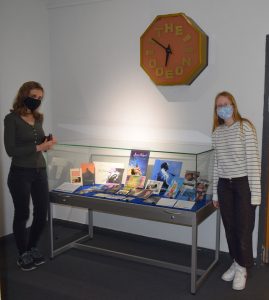In this guest post, Rosanna Armstrong and Milan George reflect on their experiences researching and creating the Queer cinema in motion exhibition.
The two research assistants on this project were tasked with creating both a physical and digital exhibition that used the objects from the Bill Douglas Cinema Museum, based on the University of Exeter campus. The material that we were able to find in the museum was very impressive and inspirational as there are materials from both underground and mainstream film. The variety in material ensured that both the digital and physical exhibition could have some similarities, but the focus of each exhibition differed due to the size of the objects. For example, in the physical exhibition books and larger posters were able to be displayed in a way that drew the eye to them due to their different size and shape to smaller postcards. In the digital exhibition, postcards were able to be enlarged and both sides were able to be displayed. Ultimately both the physical and digital exhibition were able to curated efficiently following visual lines of through and contextually.
As we were also creating a digital exhibition we settled on using Microsoft Sway as the program to display the images at the recommendation of the head curator Phil Wickham. We had to scan the objects and then upload them onto the website and chose to organise the digital exhibition visually whilst also following a subtle theme between each object that connected them to each other. This process was at times frustrating as we had to learn how to work with Sway on our own however we were able to create a slick presentation that highlighted each object individually and alongside embedded links from other forms of media such as clips from YouTube.

Milan: This project provided me with skills in curating and teamwork in a museum based field which will benefit me when I begin the Curating MFA at Goldsmiths in September 2021. I enjoyed the problem-solving that accompanied working with the physical exhibition, as well as learning the tricks of the trade when it came to displaying different objects and organising the space to appeal to the viewer as well as incorporating space for essential information. Working directly with artefacts was appealing to me as I could experience them both as a curator and as a viewer, which I personally found harder to do with the digital exhibition. I’m looking forward to seeing how viewers react to both of our exhibitions and I’ve enjoyed working as part of a small team.
Rosanna: I have found it fascinating to re-examine and digitise artefacts in the museum’s collection with connections to LGBT+ history. Throughout this project I have enhanced my research skills as well as technical abilities by learning how to use Microsoft Sway to design the digital exhibition. I have developed my curatorial skills for online as well as physical displays and have also heightened my knowledge of producing online engagement activities. I began working on this project at the start of 2020 and it has been interesting to see how it has developed and changed due to Covid-19 restrictions. It has been necessary to be innovative and adaptable. My experience as a research assistant has enhanced my ambition to pursue a career in the arts, culture, and heritage sector.
The exhibition is currently in the Bill Douglas Cinema Museum, and the digital version can be accessed online.
